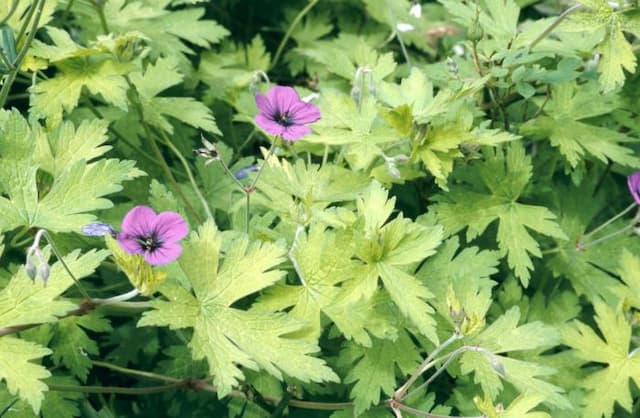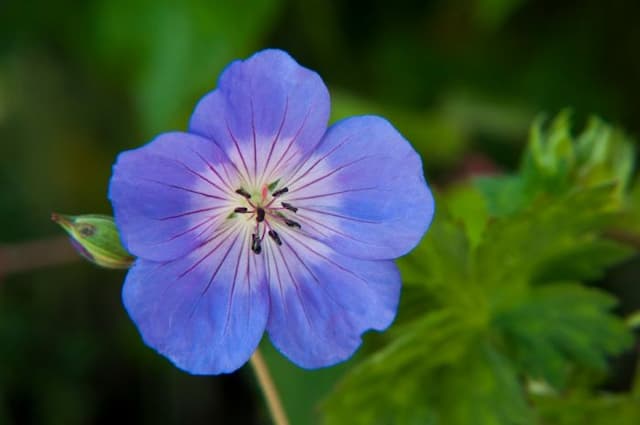Celery Scented Geranium Pelargonium ionidiflorum

ABOUT
The plant known commonly as Celery Scented Geranium is characterized by its unique aromatic foliage that resembles the smell of celery. The leaves of this plant are delicate and rounded, with a soft, velvety texture and a lush green color. Edges of the leaves are gently scalloped, providing a pleasing visual texture. Throughout the growing season, the Celery Scented Geranium produces small, charming flowers. These blossoms can be a vivid shade of pink or lavender and are often visited by pollinators like bees and butterflies. The plant has a bushy appearance, with stems that are tender and branching, creating a dense and shapely form. Despite its delicate appearance, the Celery Scented Geranium is known for being quite hardy and adaptable to various growing conditions, adding to its popularity among garden enthusiasts. The overall appearance of the Celery Scented Geranium is one of cheerful brightness and freshness, bringing a sense of vitality to any space it occupies.
About this plant
 Names
NamesFamily
Geraniaceae
Synonyms
Celery Scented Geranium
Common names
Geranium hederaefolium, Geranium tripinnatifidum, Pelargonium nervifolium, Pelargonium reniforme, Pelargonium tripinnatifidum.
 Toxicity
ToxicityTo humans
Celery-leaved geranium is not commonly listed as a toxic plant to humans. However, like many plants, it may cause mild irritation or an allergic reaction in some individuals if ingested or if the sap comes into contact with the skin. If any part of the plant is ingested, symptoms could include gastrointestinal discomfort such as nausea, vomiting, or diarrhea. It's generally advised to avoid eating any part of ornamental plants due to the potential for unknown toxicities or individual reactions.
To pets
Celery-leaved geranium is also not commonly known to be toxic to pets. Nevertheless, ingestion of plant material by pets, particularly dogs and cats, can lead to gastrointestinal upset, such as vomiting or diarrhea. Individual pets might also experience mild irritation or an allergic reaction. As with humans, eating ornamental plants is not recommended for pets, and keeping an eye on pets around such plants is the best practice to avoid any potential health issues. If any concerning symptoms are observed in a pet after ingestion, consult with a veterinarian.
 Characteristics
CharacteristicsLife cycle
Perennials
Foliage type
Evergreen
Color of leaves
Green
Flower color
Lavender
Height
1 foot (30 cm)
Spread
1.5 feet (45 cm)
Plant type
Shrub
Hardiness zones
9
Native area
South Africa
Benefits
 General Benefits
General Benefits- Ornamental Appeal: Pelargonium ionidiflorum, commonly known as celery-leaved pelargonium, adds aesthetic value to gardens with its delicate pink flowers and fragrant foliage.
- Fragrance: The plant emits a pleasant, celery-like fragrance, which can enhance the sensory experience of a garden or indoor space.
- Ease of Propagation: It can be easily propagated from cuttings, making it an economical choice for expanding a garden without additional cost.
- Drought Tolerance: Celery-leaved pelargonium is known for its ability to survive in dry conditions, making it suitable for xeriscaping and water-wise gardens.
- Pest Resistant: It tends to be resistant to many common garden pests, reducing the need for chemical pesticides and promoting a more organic approach to gardening.
- Attracts Pollinators: The flowers can attract beneficial insects such as bees and butterflies, which are important for pollinating other plants in the garden.
 Medical Properties
Medical PropertiesThis plant is not used for medical purposes.
 Air-purifying Qualities
Air-purifying QualitiesThis plant is not specifically known for air purifying qualities.
 Other Uses
Other Uses- Pelargonium ionidiflorum, commonly known as celery leaf pelargonium, can be used as an ornamental plant to add color and variety to a rock garden or a Mediterranean-themed landscape.
- The delicate, lacy foliage and small flowers of the celery leaf pelargonium make it suitable for fairy gardens or miniature landscapes, providing a whimsical touch.
- Due to its compact growth habit, the celery leaf pelargonium is an ideal choice for planting in small containers or hanging baskets, enhancing patios and balconies.
- The scent of its leaves, similar to celery, can be utilized in potpourris to create a unique fragrance blend in a home environment.
- The flowers of the celery leaf pelargonium can be used as a decorative addition to desserts and salads, providing an edible garnish that's also attractive.
- Craft enthusiasts might use dried flowers and leaves of the celery leaf pelargonium in homemade paper making, giving the paper a distinct texture and appearance.
- The plant’s ability to thrive in relatively dry conditions makes it a suitable choice for xeriscaping, contributing to water conservation in gardening practices.
- When planted in groups, the celery leaf pelargonium can provide a low-maintenance ground cover alternative in sunny areas where other plants might not flourish.
- Its distinctive foliage can be used in floral arrangements to add contrast and interest alongside other flowers, both fresh and dried.
- For fragrance collectors, the unique celery-like aroma of the leaves can be infused into oils or waters to be used in homemade perfumes or aromatherapy products.
Interesting Facts
 Feng Shui
Feng ShuiThe Celery Geranium is not used in Feng Shui practice.
 Zodiac Sign Compitability
Zodiac Sign CompitabilityThe Celery Geranium is not used in astrology practice.
 Plant Symbolism
Plant Symbolism- Comfort and Consolation: Celery-leaved geraniums are said to symbolize comfort and consolation, perhaps due to their soft and soothing fragrance, which can have a calming effect on the senses.
- Unexpected Meeting: As a species less commonly grown in gardens compared to other geraniums, the celery-leaved geranium might represent an unexpected encounter or serendipity.
- Healing: Like many herbs and plants with fragrant leaves, the celery-leaved geranium is often associated with healing properties both in a physical and emotional context.
 Water
WaterThe Celery Scented Geranium (Pelargonium ionidiflorum) prefers moderate watering, allowing the top inch of the soil to dry out between waterings. Typically, this means watering deeply once a week, but this can vary depending on climate and indoor conditions. Provide the plant with approximately 16 onzes of water for a pot with a diameter of 6 inches. During the active growing season in spring and summer, you might need to water more frequently due to increased evaporation and plant growth. Always check the soil moisture before watering to avoid overwatering, which can lead to root rot.
 Light
LightThe Celery Scented Geranium thrives in bright, indirect sunlight. It is best placed in a location where it receives plenty of light but is protected from the harsh midday sun, such as near a south-facing window with sheer curtains or an east-facing windowsill where it will get morning light. Avoid placing it in low-light conditions, as this can lead to leggy growth and fewer blooms.
 Temperature
TemperatureCelery Scented Geraniums prefer temperatures between 55 and 75 degrees Fahrenheit, but they can tolerate temperatures as low as 30 degrees Fahrenheit for short periods. Avoid exposure to temperatures below freezing, as it can cause permanent damage or kill the plant. These plants enjoy cooler nighttime temperatures, which can help promote blooming.
 Pruning
PruningPrune your Celery Scented Geranium to maintain its shape and encourage bushier growth. Snip off any leggy stems and deadhead spent flowers to promote further blooming. Pruning is best done in the spring or early summer, just before the active growing season begins. You can prune the plant occasionally throughout the year to remove dead or yellowing leaves.
 Cleaning
CleaningAs needed
 Soil
SoilThe best soil mix for Celery Leaf Pelargonium should be well-draining and fertile, with added perlite or sand to enhance drainage. The ideal soil pH for Celery Leaf Pelargonium should be slightly acidic to neutral (pH 6.0-7.0). Regular potting mix amended with organic matter can work well for its growth.
 Repotting
RepottingCelery Leaf Pelargonium should be repotted every one to two years to refresh the soil and encourage healthy growth. The best time to repot this plant is in the spring or early summer when it shows signs of becoming root-bound or the soil appears exhausted.
 Humidity & Misting
Humidity & MistingCelery Leaf Pelargonium thrives best in moderate humidity levels; however, it is adaptable and can tolerate indoor environments. Humidity levels for this plant should ideally be around 40-60% for optimal growth.
 Suitable locations
Suitable locationsIndoor
Place in bright, indirect light and water when soil is dry.
Outdoor
Full sun to partial shade, protect from harsh elements.
Hardiness zone
9-11 USDA
 Life cycle
Life cyclePelargonium ionidiflorum, commonly known as celery-scented pelargonium, typically begins its life cycle with seed germination, which requires a warm and moist environment to initiate growth. Following germination, the seedling stage sees the development of primary leaves and a root system, gradually maturing into a young plant. As it enters the vegetative stage, foliage expands and stems elongate, with the plant producing its distinctive, fragrant leaves. Flowering occurs next, during which small, lavender-pink blooms emerge, usually in summer or when conditions are favorable. After pollination, if successful, these flowers develop into fruit which contains seeds, completing the reproductive stage of the life cycle. The plant may also propagate asexually through cuttings that root and grow into new individuals, thereby continuing its life cycle.
 Propogation
PropogationPropogation time
Spring-Early Summer
Propogation: Pelargonium ionidiflorum, commonly known as Celery Scented Geranium, is often propagated by stem cuttings. This popular method involves cutting a healthy stem of about 4 to 6 inches (approximately 10-15 cm) in length from the parent plant. It's ideal to make the cut just below a leaf node, where the concentration of growth hormones is high. The lower leaves should be removed and the cut end can be dipped in a rooting hormone powder to encourage root growth, although this step is optional. The prepared cutting should then be inserted into a pot filled with a well-draining soil mixture, leaving the top leaves exposed. The pot should be kept moist and placed in indirect sunlight until new growth indicates that rooting has occurred, which can often take several weeks.









